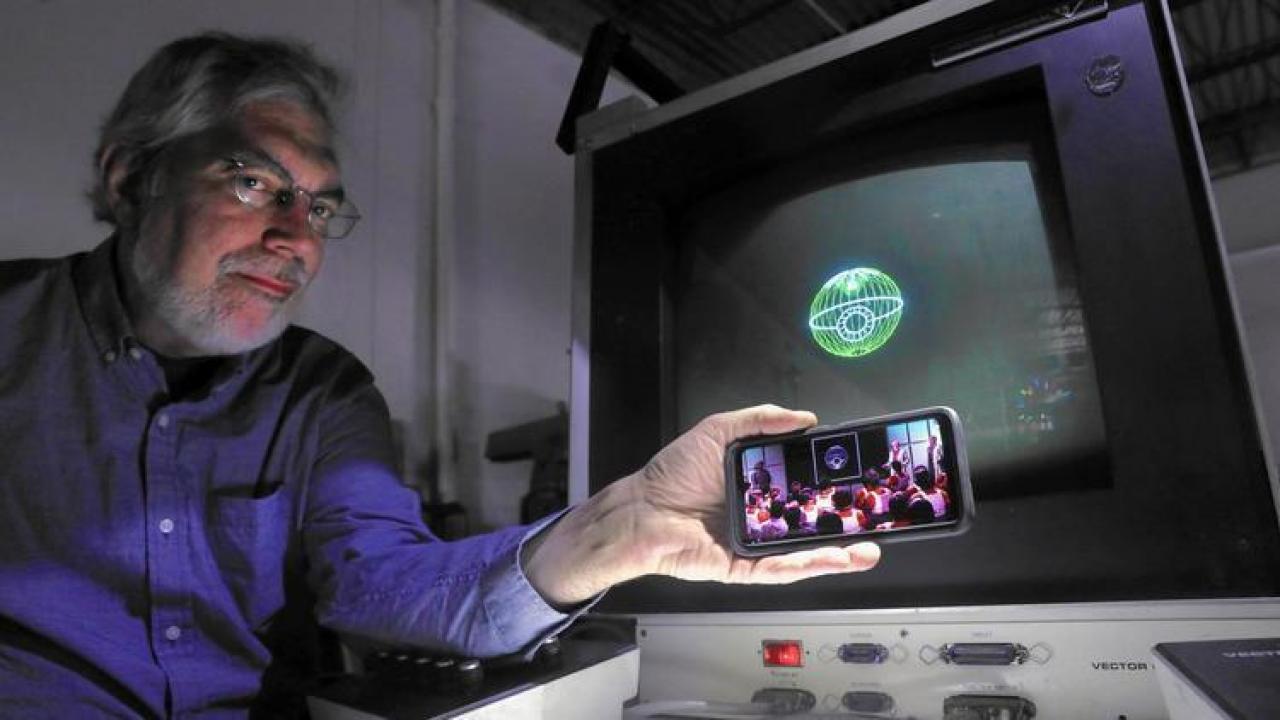|
|
||||||||||||||||||
Blueprints for 'Star Wars' Death Star were created at UIC
Participants: Steve Heminover, Thomas A. DeFanti, Larry Cuba
May 25, 2017 marks the 40th anniversary of the theatrical release of the first “Star Wars” movie. To celebrate the occasion, and to highlight Chicago’s unique connection to the film, the Chicago Tribune published an in-depth and thoughtful article by features writer Chris Borrelli on May 23, 2017, titled “Blueprints for ‘Star Wars’ Death Star were created at UIC.” See the Tribune article. See the YouTube video. Borrelli writes that the University of Illinois at Chicago (UIC) Electronic Visualization Laboratory (EVL) “has a small but curious cameo in the first ‘Star Wars’ movie - the Death Star battle plans that are presented were created there, by a small group of programmers and animators in 1976” (for the film’s release in 1977). At that time, traditional special effects were primarily done using optical (photographic) and mechanical (physical) techniques; computer generated imagery was in its infancy. The “Star Wars” movie’s special effects were done traditionally, except for one brief scene - a computer model of the Death Star that is viewed by the Rebel Alliance in their briefing room as they try to determine the best way to destroy it. California artist Larry Cuba wanted to bid on the computer graphics, but commercial software was either non-existent or proprietary, and hardware was expensive. So, Cuba approached Tom DeFanti, a computer graphics pioneer, computer science professor and co-founder of EVL, and asked to use lab’s hardware and software to create the film’s content. Though the scene took months to generate, its legacy has lasted decades. “Star Wars” came out years before Lucas created Industrial Light & Magic, and years before he created its precursor, the Lucasfilm Computer Graphics Research Group, which ultimately became Pixar. DeFanti, interviewed for this article, says “And now, [Star Wars] is the story of my life, this pleasant thread. Whenever I give a lecture, no matter what it’s about, I’m someone who worked on ‘Star Wars.’ I mean, who would have thought, in 1977, of all the things developed at the lab in Chicago, the one small piece of a film we contributed to, a movie none of us expected to be significant, would help fund a lot of people to do a lot of (computer animation).” Maxine Brown, current EVL director, is proud of the lab’s role in the movie. “Of course, it’s wonderful,” she says, “but it can date you - when they suggest that the last thing you did was develop the Death Star.” And, Cuba, a computer art pioneer, states, “I make experimental computer-animated films…There are maybe 1,000 people familiar with my films and 10 billion who know the other thing.” Steve Heminover, who worked at EVL as a UIC undergraduate when Larry Cuba was there, was able to keep the computer graphics hardware, software and associated data files from the scrap heap as the equipment aged - and, more serendipitously, was able to restore and make it operational. This article contains a video clip by Tribune photographer Chris Sweda, in which Heminover demonstrates the working computer system. And, as the Death Star’s blueprints rotate on the old vector display, Heminover plays the briefing room scene from the original movie on his smartphone in the foreground. May the Force continue! # # # # # # # In Spring 2015, to celebrate the 50th anniversary of UIC, the Alumni magazine published the article “The Circle” by Daniel P. Smith that highlights 50 moments in the history of the campus. Number 49 on the list is the “Star Wars” imagery created by UIC/EVL. https://www.evl.uic.edu/documents/uic_alumni_spring_2015_circle50.pdf Steve Heminover is a recipient of the 2007 UIC Alumni Association’s Achievement Award for his pioneering contributions to the growth of the laser display industry. http://archive.news.uic.edu/releases-2002-2012/1974-alumni-association-honors-uic-alumni-for-professional-achievement.html Email: maxine@uic.edu Date: May 24, 2017 |